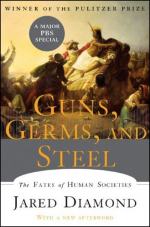|
This section contains 663 words (approx. 2 pages at 400 words per page) |

|
Chapter 18 "Hemispheres Colliding" Summary and Analysis
The biggest difference between the histories of Old World Europe and the New World Americas was the domestication of large mammal species, as discussed in previous chapters. By 1492, agriculture was widespread in Europe and while it was also widespread in the Americas, the New World had a larger percentage of hunter-gatherer societies. Agriculture in the New World also had a number of disadvantages in comparison to Eurasia. First, in the Americas, individuals depended on protein-poor corn, hand-planted seeds, and tilled the land by hand. Without large domesticated mammals, the Americans also lacked animal power to help in food production and access to manure for fertilizer. As such, food production formed one of the major ultimate causes in the differences and inequalities between Europeans and Native Americans.
One of the proximate causes of the Eurasian's conquest...
(read more from the Chapter 18 "Hemispheres Colliding" Summary)
|
This section contains 663 words (approx. 2 pages at 400 words per page) |

|




